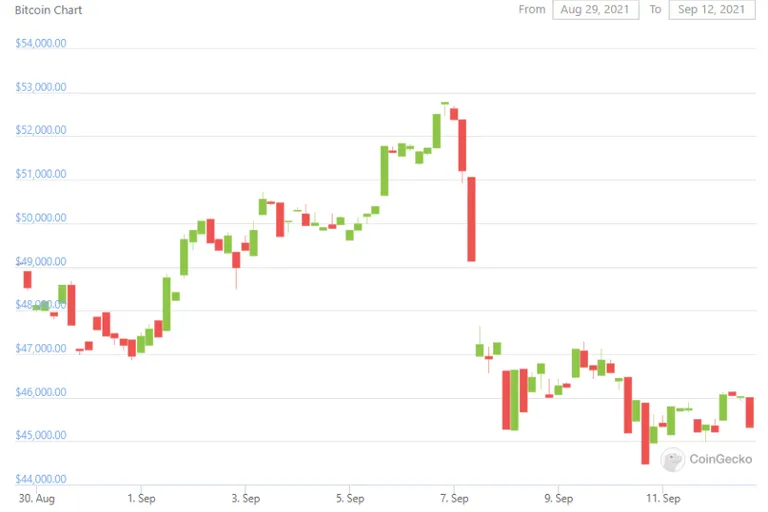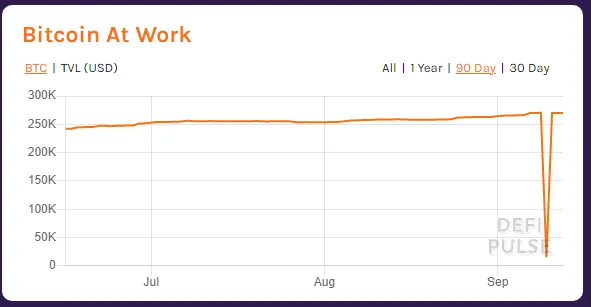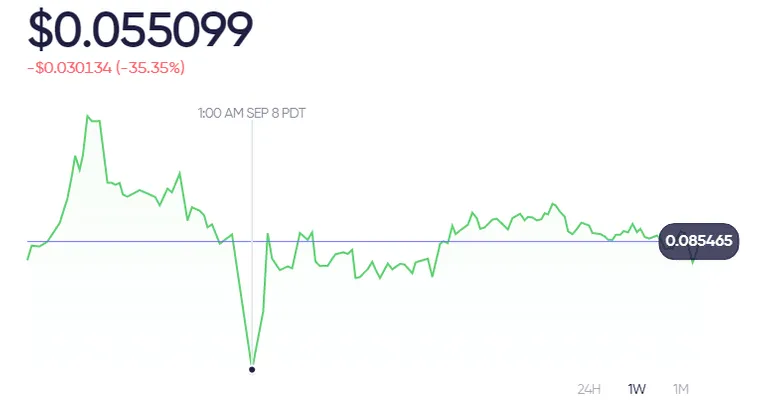Anatomy of a Flash Crash
I have mostly been focusing on “fundamentals” in this space. Occasionally I’ve referenced particular protocols or done a deeper dive, but I have mostly ignored the “news” and stayed away from some of crypto’s biggst trends. Obviously I could gather more readers more quickly if I moved with the trends, so what’s with all the stodginess?
Having a toolkit of boring “fundamentals” gives us the capability to get a much deeper understanding of everything else that is happening. It gives the capability to swim with the currents instead of having our faces torn off by the undertow.
Flash Crash
We had a negative event in crypto on Tuesday, and prices plummeted for many tokens. What happened?

It is not always easy to know the triggering event for a flash crash. In immature markets, the action of a single individual can cause it. Actions of whales can have sudden, unexpected impact. But even without knowing the initial trigger, we can know what will happen next.
Pressure on the Order Book
Most of the depth in an order book is provided by market makers. As we saw in ‘Order Books and Market Makers’, the trade volume available within 2% of the spot price can sometimes be incredibly small. A single whale can put pressure on the order book intentionally (or accidentally, in the case of a ‘fat finger’ mistake — when a trader mistakenly pushes two keys instead of one and their total is 10x or more larger than they intended) by trading through all of the liquidity available within 2% of spot.
Two weeks ago, I wrote “the market maker time-frame is very short-term, and it is considered ‘inventory risk’ to get caught holding something for an extended time period”.
To protect themselves from inventory risk, many market makers will have ‘hidden stops’. These orders don’t appear on the order book, but are triggered by prices reaching a certain range. These may be placed manually from the trader reviewing the order book (or the chart) and setting stop orders below critical support points, or they may be calculated automatically by the trader’s algorithm. Either way, when the whale puts enough pressure on the market, the market makers bail. The further you get from the ‘normal’ price before the event, the fewer market makers there are continuing to provide liquidity.
Like market makers, savvy speculators use stop orders to protect themselves from losses, or to lock in gains as soon as a trade begins to move against them. These put even more pressure on the order book.
Liquidations
When you have a tiny “edge”, you amplify it with large amounts of leverage. Speculators and arbitrageurs usually trade with as much leverage as their risk models permit. Since arbitrage is theoretically ‘risk-free’ positions, that means as much leverage as they are permitted…
Apply enough pressure, and leveraged traders begin to face margin calls. In traditional finance, it is common for brokers to offer the trader an opportunity to post more capital before liquidating a position. The larger the losses faced, the more likely it is that the broker begins liquidating without giving the trader any opportunity to deposit more money.
In crypto protocols, there are collateralization requirements, and liquidation procedures are usually triggered automatically when requirements are breached. That can lead to immediate liquidations, or to liquidation ‘auctions’ where a position is seized and sold to the highest bidder.
These liquidation events put even more pressure on already thin order books, and sometimes the market just… kind of… buckles? And that’s a flash crash.

https://defipulse.com/btc
Concentrated liquidity (order books or UniV3) makes it harder to cause a deliberate flash crash, but distributed liquidity (most liquidity pools) makes it easier to soak up the subsequent liquidations .A blend of concentrated liquidity and distributed liquidity is probably the healthiest market structure — and DeFi is really good at providing this liquidity blend… it just isn’t big enough yet to stand up to bully whales.
Taking Action
Knowing that these events will continue to happen, how can you protect yourself? Or better yet, how can you prepare to take advantage of these events?
First, what kind of trader are you? Long-term market cycles in crypto tend to be ~4 years from peak to peak, due to the regular bitcoin halving. If your intended hodl time frame isn’t at least 4 years, you may need to think like a speculator instead of an investor! If you are a long-term investor, then buying into crashes can be an amazing opportunity. I have seen the spring 2020 crash described as “generational” opportunities — the rare chance to invest into a big dip can lead to outstanding returns… the kinds of returns that build generational wealth.
Second, consider mean reversion v trend. Since it can change the prevailing mood, a flash crash can be the first domino, tipping a froth market into a long-term decline. Know whether you are better at trading mean reversion or better at trading trend, and how your system is impacted by flash crashes.
Third, are you still using market orders? If you plan in advance what your approach will be to protect yourself and take advantage of flash crashes, you can beginning using more sophisticated trade types. You can use stop orders to protect yourself (or sophisticated trading programs that submit orders on your behalf when your conditions are met). You can submit lowball orders to dex aggregators like matcha.xyz. If there is a liquidity event, your lowball order eventually gets arbed against the most impacted Dex, and you get deeply discounted coins at the fire sale, even if you are sleeping!

https://matcha.xyz/markets/1/0x2d94aa3e47d9d5024503ca8491fce9a2fb4da198
My Approach
I find it helpful to trade across different time frames. I have short term positions with sensitive stops that move me to the sidelines early in the liquidation cycle. I add to long term positions as the flash crash deepens. When the flash crash is over and a new trend becomes clear, I bring my short term capital off the sidelines and start actively trading again. Part of my response is planned in advance, as described in step 3 above.
Since I’m full-time crypto now, most of my approach is reactive… as things begin to happen, my automated trades spring into action and my phone goes off with alerts. I hope to my computer and start evaluating markets, looking for where new trends have emerged (or where the longer term trend is intact and I think I can safely trade the reversion and then ride it into the next uptrend). I hope into a few discords and see what protocols are breaking and where liquidations might lead to more opportunity in the cover. In effect, I’m trying to proactively turn every flash crash into a generational event.
Conclusion
Understanding what is happening in the markets helps us to make better decisions. We referenced several weeks worth of “fundamentals” discussions to map out what happens in a flash crash, how to protect ourselves, and how to profit from it.
My hope is that you can see why I focus so much on fundamentals. If any paragraph didn’t make sense to you, click to the previous articles and review those first. If you’re still struggling, please comment and let me know which points are not clear enough.
I love finance, and I love helping others to understand and appreciate its complexity! If this helped you in any way, please subscribe and share it with others so we can all get rich from DeFi together.
This article was originally published on Savage Corner on 12 Sep 2021. Subscribe for free to get new content as it comes out!
Not financial or tax advice. This newsletter is strictly educational and is not investment advice or a solicitation to buy or sell any assets or to make any financial decisions. This newsletter is not tax advice. Talk to your accountant. Do your own research.
Disclosure. From time-to-time I may add links in this newsletter to products I use. I may receive commission if you make a purchase through one of these links. Additionally, the Savage Corner writers hold crypto assets and actively trade in certain markets.
Posted Using LeoFinance Beta
Interesting and great writing Joe, I am mostly a DCA kind of investor and always try to trade the more active days as the trend continues up !1UP !PGM !PIMP !CTP
Aw man @dynamicrypto, you are out of PIMP to slap people.
Go Stake some more and increase your PIMP power.
(We will not send this error message for 24 hours).
Read about some PIMP Shit or Look for the PIMP District
BUY AND STAKE THE PGM TO SEND A LOT OF TOKENS!
The tokens that the command sends are: 0.1 PGM-0.1 LVL-2.5 BUDS-0.01 MOTA-0.05 DEC-15 SBT-1 STARBITS-0.00000001 BTC (SWWAP.BTC)
Discord
Support the curation account @ pgm-curator with a delegation 10 HP - 50 HP - 100 HP - 500 HP - 1000 HP
Get potential votes from @ pgm-curator by paying in PGM, here is a guide
I'm a bot, if you want a hand ask @ zottone444
Thanks for your comment! I do think DCA has its time and place, and it's what I definitely recommend for anybody that isn't going to actively manage their crypto full-time.
You have received a 1UP from @dynamicrypto!
@neoxag-curator, @pal-curatorAnd they will bring !PIZZA 🍕
Learn more about our delegation service to earn daily rewards. Join the family on Discord.
investing into crypto is wild. So much speculation and emotion with little to no clarity on how it may pan out with all the wild cards like lack of regulation and oversight that allow con men and the government spooks alike to take advantage of the average Joe.
Thanks for getting back to posting on Hive and sharing your valuable insights with us!
You're welcome! The last month especially has been really wild, but it has motivated me to get back into writing (and cross-posting my older material that didn't make it onto Hive yet).
Some people asked me to write about the Terra collapse, which I think has been done to death, but I might still write about my own arbitrage adventure with it. I have a few other drafts I want to finish up first, though.
The Terra thing was interesting and yeah people I am sure want to understand better how our hbd system may correlate to such an attack which would be seemingly nearly impossible.
Finally it is spring time in Oregon! Hope you are getting out and enjoying it!
The 'haircut' that kicks in if we exceed the debt threshold precludes HBD from falling to a total bank run like what happened to LUNA. That doesn't mean HBD can't trade at discount when confidence in the mechanism isn't high enough.
God bless you for this smart post. I've missed some of the previous ones, so I need to go back and read them. Keep them coming as it is much needed.
Thanks, I have a few more in the backlog that still need posted to Hive, and I'm starting to write new content again as well.
I find I'm a terrible short term trader, and while I value reading this post, I trade on trends, hype and the overall crypto space. Not saying it's the best strategy, but it's worked well for me.
Posted Using LeoFinance Beta
I'm a big fan of matching your trading style to your personality. (Learn skills to be the best version of you, but still be you!)
Kind of made my head spin a little. I need to read this after some research.
Yes, this wasn't exactly 101 level, but built on all the articles that were linked throughout the text. It would be a bit hard to follow without familiarity with the underlying concepts.
Sounds like I need to deep delve your blog